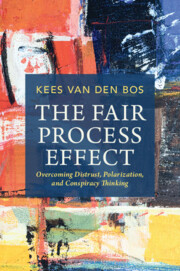Book contents
- The Fair Process Effect
- The Fair Process Effect
- Copyright page
- Contents
- Preface
- Acknowledgments
- Part I Introduction
- Part II Perceiving Procedural Fairness
- Chapter 2 Criteria
- Chapter 3 Psychological Processes
- Part III The Fair Process Effect
- Part IV Examining Societal Discontent
- Part V Overcoming Societal Discontent
- References
- Index
Chapter 2 - Criteria
from Part II - Perceiving Procedural Fairness
Published online by Cambridge University Press: 26 October 2023
- The Fair Process Effect
- The Fair Process Effect
- Copyright page
- Contents
- Preface
- Acknowledgments
- Part I Introduction
- Part II Perceiving Procedural Fairness
- Chapter 2 Criteria
- Chapter 3 Psychological Processes
- Part III The Fair Process Effect
- Part IV Examining Societal Discontent
- Part V Overcoming Societal Discontent
- References
- Index
Summary
Chapter 2 examines criteria that people use when forming perceptions of how they and others have been treated is fair or unfair. One of the important criteria that people use is whether they were given sufficient opportunities to voice their opinions about important issues at stake. It is crucial that voiced opinions are given due consideration. Being treated in a polite and respectful manner by people, and especially people of power, is also among the core criteria for evaluating procedural fairness. Generally being treated in a fair and just manner by competent and professional authorities is also among the important criteria of perceived procedural fairness. Taken together, perceived procedural fairness boils down to feeling to be a full-fledged member of your community and society and, ideally, the entire world.
Keywords
- Type
- Chapter
- Information
- The Fair Process EffectOvercoming Distrust, Polarization, and Conspiracy Thinking, pp. 21 - 30Publisher: Cambridge University PressPrint publication year: 2023

